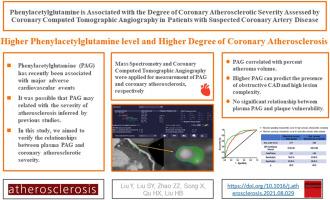Atherosclerosis ( IF 4.9 ) Pub Date : 2021-08-13 , DOI: 10.1016/j.atherosclerosis.2021.08.029 Yang Liu 1 , Shaoyan Liu 2 , Zhizhuang Zhao 3 , Xiang Song 4 , Haixian Qu 4 , Hongbin Liu 5

|
Background and aims
Phenylacetylglutamine (PAG), a gut microbiota metabolite, has recently been found to be associated with major adverse cardiovascular events. In this study, we analyzed the relationship between plasma PAG and coronary atherosclerotic severity assessed by coronary computed tomographic angiography (CCTA).
Methods
We enrolled consecutive patients with suspected coronary artery disease (CAD) who underwent CCTA. Plasma PAG was measured by mass spectrometry. Coronary atherosclerotic severity was evaluated based on plaque burden and plaque vulnerability. Plaque burden was quantified as percent atheroma volume (PAV), CCTA-derived SYNTAX score (CT-SYNTAX) and CAD reporting and data system score (CAD-RADS). Plaque vulnerability was evaluated by the presence of adverse characteristics.
Results
A total of 686 patients were enrolled. The patients were divided into two groups based on median plasma PAG (3.25 μM). A correlation was found between plasma PAG and PAV (r = 0.499, p < 0.01). Patients with obstructive CAD (CAD-RADS>3) and high coronary lesion complexity (CT-SYNTAX≥23) had higher plasma PAG (2.04 vs. 3.8 μM and 2.85 vs. 4.49 μM, respectively; p < 0.01 for all). After adjustment for confounding factors, plasma PAG remained associated with PAV (β: 0.98, p < 0.01), and patients in the higher PAG group had higher risks of obstructive CAD (odds ratio [OR]: 1.88, p < 0.01) and high coronary lesion complexity (OR: 1.47; p < 0.01). In addition, a high plasma PAG level (≥3.25 μM) was not an independent predictor of the presence of high-risk plaques.
Conclusions
There was an independent association between plasma PAG levels and the coronary atherosclerotic burden among patients with suspected CAD.
中文翻译:

苯乙酰谷氨酰胺与疑似冠状动脉疾病患者冠状动脉计算机断层扫描血管造影评估的冠状动脉粥样硬化严重程度有关
背景和目标
苯乙酰谷氨酰胺(PAG)是一种肠道微生物群代谢物,最近被发现与主要的心血管不良事件有关。在这项研究中,我们分析了血浆 PAG 与冠状动脉计算机断层扫描血管造影 (CCTA) 评估的冠状动脉粥样硬化严重程度之间的关系。
方法
我们连续招募了接受 CCTA 的疑似冠状动脉疾病 (CAD) 患者。通过质谱法测量血浆PAG。根据斑块负荷和斑块易损性评估冠状动脉粥样硬化的严重程度。斑块负荷被量化为粥样斑块体积百分比 (PAV)、CCTA 衍生的 SYNTAX 评分 (CT-SYNTAX) 和 CAD 报告和数据系统评分 (CAD-RADS)。斑块脆弱性通过不利特征的存在来评估。
结果
共招募了 686 名患者。根据中位血浆 PAG (3.25 μM) 将患者分为两组。血浆 PAG 和 PAV 之间存在相关性(r = 0.499,p < 0.01)。阻塞性 CAD (CAD-RADS>3) 和高冠状动脉病变复杂性 (CT-SYNTAX≥23) 的患者血浆 PAG 较高(分别为 2.04对3.8 μM 和 2.85对4.49 μM; 所有p < 0.01)。调整混杂因素后,血浆 PAG 仍与 PAV 相关(β:0.98,p < 0.01),高 PAG 组的患者患阻塞性 CAD 的风险更高(比值比 [OR]:1.88,p < 0.01)和高冠状动脉病变复杂性(OR:1.47;p < 0.01)。此外,高血浆 PAG 水平(≥3.25 μM)并不是高危斑块存在的独立预测因素。
结论
在疑似 CAD 患者中,血浆 PAG 水平与冠状动脉粥样硬化负荷之间存在独立关联。











































 京公网安备 11010802027423号
京公网安备 11010802027423号